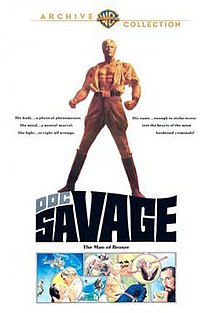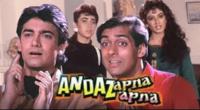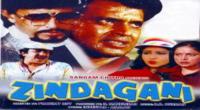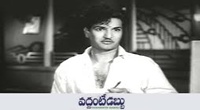Doc Savage: The Man of Bronze is a 1975 American action film starring Ron Ely as pulp hero Doc Savage. This was the last film completed by pioneering science fiction producer George Pal. It was directed by Michael Anderson, who had previously directed another big-budget adventure film, Around the World in 80 Days.
| Doc Savage: The Man of Bronze | |
|---|---|
DVD Cover | |
| Directed by | Michael Anderson |
| Produced by | George Pal |
| Written by | Joe Morhaim George Pal |
| Based on | Doc Savage by Henry W. Ralston John L. Nanovic Lester Dent |
| Starring | Ron Ely |
| Narrated by | Paul Frees |
| Music by | Don Black Frank De Vol John Philip Sousa |
| Cinematography | Fred J. Koenekamp |
| Edited by | Thomas J. McCarthy |
| Distributed by | Warner Bros. |
Release date |
|
Running time | 112 minutes |
| Country | United States |
| Language | English |
Screenplay
In 1936, Doc Savage (Ron Ely) returns to New York City following a visit to his Arctic hideaway, the Fortess of Solitude. He learns that his father has died under mysterious circumstances while exploring the remote interior of the Central American Republic of Hidalgo. While examining his father's personal papers, Doc finds himself the target of an assassination attempt. Doc Savage chases and corners the sniper on the nearby Eastern Cranmoor Building, but the would-be assassin loses his footing and falls to his death. Examining the body, Doc discovers that his assailant is a Native American with peculiar markings; his fingertips are red, as if dipped in blood, while his chest bears an elaborate tattoo of the ancient Mayan god Kukulkan. Returning to his penthouse headquarters, Doc finds that intruders have destroyed his father's personal papers. Vowing to solve his father's murder, Doc Savage flies to Hidalgo with "The Fabulous Five", his brain trust, at his side.
Waiting for Doc Savage's arrival is the international criminal and smuggler Captain Seas (Paul Wexler) who repeatedly attempts to kill Doc and his friends, culminating in a wild melee onboard his yacht, the Seven Seas. Meanwhile, Doc's investigation uncovers that, years ago, Professor Savage received a vast land grant in the unexplored interior of Hidalgo from the Quetzamal, a Mayan tribe that disappeared 500 years ago. However, Don Rubio Gorro (Bob Corso) of the local government informs Doc that all records to the land transaction are missing. Doc receives unexpected help from Gorro's assistant, Mona Flores (Pamela Hensley), who saw the original papers and offers to lead Doc and his friends to the land claim.
Following clues left by his father, Doc and his friends locate the hidden entrance into a valley where the lost Quetzamal tribe lives. Doc separates from the group and finds a pool of molten gold. Doc also learns that Captain Seas is using the Quetzamal natives as slave labor to extract the gold for himself. Meanwhile, Seas' men capture Mona and The Fabulous Five, and Seas unleashes the Green Death, the same airborne plague that killed Doc's father and keeps the Quetzamal tribe under his control. Doc overpowers the Captain after a protracted clash of different fighting styles and forces Seas to release his friends, whom Doc then treats with a special antidote. Seeing their leader captured, the Captain's men try to escape with the gold, but exploding dynamite causes the pool of gold to erupt, covering the henchmen, including Don Rubio Gorro, in molten metal. Freed from Captain Seas, Chief Chaac (Victor Millan) offers the gold and land grant to Doc, who replies, "I promise to continue my father's work ... his ideals. With this limitless wealth at my disposal, I shall be able to devote my life to the cause of justice."
Doc Savage returns to the United States and performs acupuncture brain surgery on Captain Seas to cure him of his criminal behavior. Later, during Christmas season, Doc Savage encounters the former supervillain, who is now a bandleader for The Salvation Army, flanked by his former paramours Adriana and Karen. Arriving back at his penthouse headquarters from shopping, Doc hears an urgent message about a new threat that could cost millions of lives recorded earlier on his telephone answering machine. Doc Savage leaps into action and speeds to his next adventure.
- Ron Ely as Clark "Doc" Savage Jr.
- Paul Gleason as Major Thomas J. "Long Tom" Roberts
- William Lucking as Colonel John "Renny" Renwick
- Michael Miller as Lieutenant Colonel Andrew Blodgett "Monk" Mayfair
- Eldon Quick as Professor William Harper "Johnny" Littlejohn
- Darrell Zwerling as Brigadier General Theodore Marley "Ham" Brooks
- Paul Wexler as Captain Seas
- Pamela Hensley as Mona Flores
- Bob Corso as Don Rubio Gorro
- Federico Roberto as El Presidente Don Carlos Avispa
- Janice Heiden as Adriana
- Robyn Hilton as Karen
- Victor Millan as King Chaac
- Paul Frees as Narrator (uncredited)
Other noteworthy casting included:
- Cult actor Robert Tessier as one of Captain Seas’ henchmen.
- Cult actor Michael Berryman as Juan Lopez Morales, Hidalgo's chief coroner.
- Legendary stuntman Dar Robinson as the Mayan would-be assassin.
- Carlos Rivas, who played the renegade Mayan shaman Kulkan, also appeared in episodes "The Ultimate Duel" and "Perils of Tanga" of the 1966 NBC TV series Tarzan starring Ron Ely.
- Grace Stafford, the wife of animation producer Walter Lantz, played an elderly woman who was helped across the street by a Boy Scout near the end of the film. George Pal and Lantz were good friends, and Lantz’s most famous creation, Woody Woodpecker, often made a cameo appearance in Pal's films. Ms. Stafford provided the voice for Woody Woodpecker.
Film rights
As co-creator of Doc Savage, author Lester Dent retained the radio, film, and television rights to the character as part of his contract with Street and Smith Publications, publishers of the Doc Savage pulp magazine. Although Dent succeeded in launching a short-lived radio program, he was never able to interest Hollywood in a Doc Savage film. Upon Dent's death in 1959, his widow, Norma Dent, acquired the radio, film, and television rights to Doc Savage.
Unsuccessful project
The production team of Mark Goodson and Bill Todman announced the intention to produce a Doc Savage film to cash in on the popularity of the re-issued pulp novels by Bantam Books and the James Bond craze sweeping the movies. The film would be based on the July 1934 pulp novel The Thousand-Headed Man, with Chuck Connors as Doc, for a 1966 release. Unfortunately, the producers and Condé Nast Publications, the new copyright owner of the Doc Savage brand, failed to secure the film rights from the estate of Lester Dent. By the time the legal issues had been resolved, the production team and cast had moved on to do the offbeat western Ride Beyond Vengeance.
Only the one-shot comic book movie tie-in published by Gold Key, with cover artwork by James Bama, remains to mark this aborted film undertaking.
Development
Producer George Pal secured the film and television rights from Norma Dent with the intention of launching a film franchise, followed by an eventual television series. Pal originally contacted Steve Reeves for the role of Doc Savage but when filming was about to begin a Hollywood writers strike put the film on hold, and Reeves and the original director were replaced. Michael Anderson would eventually direct the movie.
Writing
Pal and Joe Morhaim wrote the screenplay based on The Man of Bronze, the first Doc Savage adventure, with additional story elements from other Doc Savage adventures, such as the November 1938 novel The Green Death and the January 1935 novel The Mystic Mullah. The villainous Captain Seas, played by Paul Wexler, was based on the flamboyant and brutal Captain Flamingo — unrelated to the Canadian television character of that name — from the February 1936 pulp novel Mystery Under the Sea.
Doc Savage: The Man of Bronze was fairly faithful to the novels and characters, which included such elements as:
- Doc's trilling (although it sounded like bells tinkling rather than a more lifelike trilling (such as a cat purring)
- Bickering between Monk and Ham
- Renny's signature expletive "Holy Cow!"
- Renny's love of slamming his fists through solidly constructed doors or door-panels.
- Monk's pet pig, Habeas Corpus
- Doc's Fortress of Solitude
- The penthouse headquarters on the 86th floor of the Empire State Building.
- The Crime College and Doc's brain surgery techniques to remove the criminal element from crooks he'd captured, making them incapable of committing further crimes.
- Doc's dramatic descent down a skyscraper elevator shaft
- Doc's daily two-hour exercise regime
- Doc standing on an automobile's running board in hot pursuit.
- Johnny's use of long, obscure words when simple words would suffice.
- Johnny's signature expletive "I'll be superamalgamated!"
- A plethora of retro gadgetry such as heat detector, globes of fire-fighting chemicals (extinguisher globes), phonograph-based recording machine, remote-controlled aircraft, a ray gun disguised as a cigarette lighter, lightweight bullet-proof vests, miniaturized SCUBA-type underwater breathing gear, and the Whizzer, a prototype helicopter—all his inventions and designs.
Other aspects of the Doc Savage mythos were modified for the movie. For example, The film takes place in 1936, but the original pulp novel was published in March 1933. Most Doc Savage chronologies place the events in The Man of Bronze in early 1931 prior to the official opening of the Empire State Building, the implicit location of Doc's 86th floor penthouse headquarters. The film does not mention that Doc's father, Professor Clark Savage, Sr., was instrumental in raising his son from the cradle to become the supreme adventurer under the tutelage of a blue-ribbon group of distinguished scientists. The Seven Seas is actually the name of Doc Savage's private motor yacht in the pulp novels written by Lester Dent. Finally, Long Tom (Paul Gleason) mentions that Monk, Ham, Renny, Johnny, and he first met Doc Savage while fighting in the trenches during World War I and vowed to work together against evil-doers after the war. The 1991 novel Escape From Loki by Philip José Farmer retroactively tells the story of how Doc first met The Fabulous Five in a high-security German POW camp in 1918. Finally, the opening titles used the same typography (pictured) used in the Bantam Books reprints of the Doc Savage pulp novels.
Casting
This section, except for one footnote, needs additional citations for verification. (October 2015) (Learn how and when to remove this template message) |
Ron Ely's involvement extended beyond starring in the lead role. The portrait of Professor Clark Savage, Sr., in Doc Savage's penthouse headquarters is Ely wearing a vintage safari outfit and pith helmet, with a handlebar moustache. Pamela Hensley made her film debut in this motion picture. Paul Frees, provided the uncredited voiceover narration for the opening title sequence.
Filming
Principal photography was done in southern California. Scenes involving the fictitious Eastern Cranmoor Building in New York City were filmed underneath the clock tower of the art deco Eastern Columbia Building in downtown Los Angeles.
The film features a rare Cord Model 810 convertible coupe (license number NY 36 486-539) and a vintage Lockheed L-12A Electra aircraft, serial number 1203, original tail number NC16077, first registered to Continental Oil in 1936. The plane became famous as G-AFTL when flown by Sidney Cotton, who used it for spying on the Germans during World War Two. It was later owned by air-show pilot Art Scholl and flown in the 1976 two-part TV miniseries Amelia Earhart, the 1976 CBS-TV adventure series Spencer's Pilots, and the 1977 TV movie The Amazing Howard Hughes.
Style
Debate continues as to who was responsible for the camp content of Doc Savage: The Man of Bronze, the studio or George Pal and his production team. Among the many examples of over-the-top camp include Don Rubio Gorro (Bob Corso) rocking himself to sleep in an adult-sized baby crib, with Beautiful Dreamer as its musical cue, the animated twinkle in the eye of Doc Savage (Ron Ely) at the beginning of the film and later when Doc tells Mona (Pamela Hensley) that she was a brick. "La Cucaracha", played by a flute was used in an up-tempo musical cue, during the attempted escape of Captain Seas' henchmen from the Valley of the Vanished, and finally, an applause soundtrack was added following Doc's recitation of his personal code.
Music
The film is also remembered for its theme song arranged by Frank De Vol, based on John Philip Sousa's The Thunderer. Sousa’s music was intended to evoke a patriotic theme for Doc Savage: The Man of Bronze and attempted to emulate the success that director George Roy Hill and composer Marvin Hamlisch had achieved when they used the ragtime music of Scott Joplin for the 1975 caper film The Sting. Both Sousa and Joplin were turn-of-the-century composers, and their music was not contemporaneous to the period that these 1930s nostalgia films were set. The credit acknowledging Sousa's score has the letters "USA" in his last name highlighted in red, white, and blue.
 Story of movie Doc Savage Film :
Story of movie Doc Savage Film : .jpg)
.jpg)



.jpg)
.jpg)














